Podcast
Questions and Answers
What is a holoenzyme?
What is a holoenzyme?
- An inactive enzyme without its cofactors
- A complete, functional enzyme with its cofactors (correct)
- An enzyme without an active site
- A partially functional enzyme
What is the role of enzymes in lowering the energy barrier for reactions?
What is the role of enzymes in lowering the energy barrier for reactions?
- They directly participate in the reaction
- They lower the activation energy required for the reaction to occur (correct)
- They increase the activation energy required for the reaction to occur
- They have no effect on the activation energy
What is the active site of an enzyme?
What is the active site of an enzyme?
- The region of the enzyme without any specific function
- The part of the enzyme that participates in the reaction
- The area where cofactors bind to the enzyme
- The specific region where the substrate binds and catalysis occurs (correct)
What happens when a substrate binds to an enzyme's active site?
What happens when a substrate binds to an enzyme's active site?
What is the function of enzymes in biological reactions?
What is the function of enzymes in biological reactions?
Study Notes
Holoenzyme
- A holoenzyme consists of an enzyme that is active and complete, including its essential cofactor(s).
- The cofactor can be a metal ion or a coenzyme, which aids the enzyme in its catalytic activity.
Role of Enzymes
- Enzymes lower the activation energy required for chemical reactions, which increases reaction rates.
- This lowering of the energy barrier allows reactions to proceed more quickly and efficiently at physiological temperatures.
Active Site of an Enzyme
- The active site is a specific region on the enzyme where substrate molecules attach.
- This region is typically a unique shape that matches the substrate, allowing for an effective interaction.
Substrate Binding
- When a substrate binds to an enzyme's active site, an enzyme-substrate complex forms.
- This interaction results in changes in the enzyme's shape, enhancing the conversion of substrate to product.
Function of Enzymes in Biological Reactions
- Enzymes facilitate biochemical reactions, acting as catalysts that speed up processes essential for life.
- They are highly specific, meaning each enzyme typically catalyzes only one type of reaction or acts on a specific substrate.
Studying That Suits You
Use AI to generate personalized quizzes and flashcards to suit your learning preferences.
Description
Test your knowledge of enzymes and biochemistry with this quiz based on a lecture by Dr. Michael Mounir from the Faculty of Science at Helwan University. Learn about enzyme structure, function, and catalytic activity.




